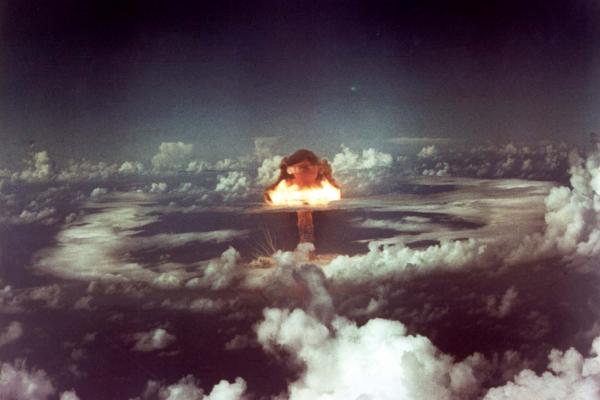
The international arms-control architecture is at risk of collapsing. Ernesto Zedillo warns of the risks of a new nuclear arms race between the US and Russia, and urges every nuclear-armed state to act responsibly to prevent catastrophe. First published in YaleGlobal Online.
Thirty years ago, when the Berlin Wall was brought down marking the end of the Cold War, the threat of conflict between two nuclear-armed, ideologically opposed superpowers receded, and my generation, which had grown up in the shadow of the bomb, breathed a sigh of relief. Although the nuclear threat did not vanish then, it certainly became subdued as the process of disarmament and control seemed to move forward along a clear path of no return.
Today, the geopolitical and security climate is far removed from the heady days of 1989. Walls are back in fashion, and a new nuclear arms race risks taking the whole world back to the old tensions and conceivably to an even more dangerous situation than during the Cold War era, when deterrence provided effective stability – although a perverse one by being based on the threat of mutual destruction. After the end of the Cold War, deterrence had persisted, but was auspiciously accompanied by incremental disarmament. Now the foundations of deterrence are seriously being eroded while disarmament is being stopped, giving way to a new era of rearmament. Arms control is fast unravelling and incredibly the United States, the unquestionable victor of the Cold War, is leading the march to destroy it.
<p>Fixing and improving the INF Treaty could then be part of an agenda to revitalize the process of incremental arms control by all nuclear powers.</p>
Ernesto Zedillo - Elder
This process is not new, but has accelerated over the last two years. The unravelling goes back to 2002, when the United States withdrew unilaterally from the Anti-Ballistic Missile Treaty that had been in force for three decades. At the time, the decision was justified as necessary to allow the US to build a missile defence system, not against existing nuclear powers but rather against rogue states that might get access to nuclear weapons. Not credible to Russia, this action triggered the decision to start rebuilding its nuclear capacities.
The US government has now admitted explicitly in its recently released Missile Defense Review that its anti-ballistic systems are intended to defend against other nuclear powers, like Russia and China. This clarity of intent leads to the obvious question: If the United States can protect itself against a retaliatory nuclear attack, why would it not be tempted to attack first? The likelihood of the latter scenario severely undermines deterrence, with consequences for reigniting the arms race.
Avoiding such reignition has not been helped by other actions taken over the years by the US government, for example the 2010 decision to spend $1 trillion dollars over 30 years to modernize the US nuclear arsenal, a program embraced by the Trump administration and enlarging its planned budget by more than 60 percent.
The commitment to the nuclear renovation program was part of the bargain to get the New START – Strategic Arms Reduction Strategy – ratified by the US Senate in early 2011. This US-Russia agreement provided for a significant reduction of the strategic nuclear capabilities of both countries. Yet the treaty expires in 2021, and the US government has refused to consider its extension.
The most important evidence of President Donald Trump’s disregard for nuclear disarmament and non-proliferation had been, until recently, his decision to withdraw from the Iran nuclear deal last year. This perplexing step now has strong competition as the most wrongheaded one of the nuclear policies of his administration. The United States’ recent suspension of the Intermediate-Range Nuclear Forces Treaty, followed almost immediately by Russia’s, could be an inflection point in a global arms race with widespread consequences for international security. The treaty, agreed to by Ronald Reagan and the Soviet Union’s Mikhail Gorbachev in 1987, was the first to eliminate a whole category of nuclear weapons.
<p>Each nuclear-armed state has responsibility to prevent the collapse of the international arms-control architecture.</p>
Ernesto Zedillo - Elder
There is evidence that both sides have violated the INF Treaty in recent years. If both countries fail to reconsider their suspension of the treaty, it will further accelerate a sinister missile competition, a threat not only to the United States and Russia’s security but also to many other countries. For one thing, Russia will now be legally unconstrained from deploying land-based nuclear missiles aimed at Europe. For another, China will take notice that the United States could install intermediate-range missiles within range of its territory. This would threaten the security of several key US allies in the region, a scenario that could accelerate nuclear and conventional weapons proliferation in Asia. At this rate, it won’t be long before several signatories to the Treaty on the Non-Proliferation of Nuclear Weapons reconsider their commitment to such a remarkable multilateral instrument.
There is still a six-month window of opportunity for the United States and Russia to start seriously addressing their mutual accusations of non-compliance with the INF Treaty. Their goal should not just be to avoid the treaty’s definite demise, but also to pursue a more ambitious agreement on land-based intermediate-range missiles that would include other nuclear powers, especially China. Fixing and improving the INF Treaty could then be part of an agenda to revitalize the process of incremental arms control by all nuclear powers. The goal would not be to abolish nuclear weapons, an objective that unfortunately is chimerical any time soon, but rather to minimize the risks that they pose for international peace and security.
The Elders, a group founded by the great statesman Nelson Mandela and chaired by Kofi Annan during the last years of his admirable life, is working toward this goal and offers four pillars to explain its minimization agenda:
- Doctrine: Every nuclear-armed state should make an unequivocal “no first use” declaration.
- De-alerting: As many weapons as possible must be taken off their current high-alert status.
- Deployment: The proportion of nuclear weapons currently operationally deployed must be drastically reduced.
- Decreased numbers: As was done before, the total count of nuclear warheads in existence should be vastly reduced.
The international arms-control architecture is at risk of collapsing. Every nuclear-armed state has a grave responsibility to prevent this catastrophe from happening. The responsibility of the United States is unquestionably more significant. Even the great victor of the Cold War is condemned to lose any nuclear war simply because if that happens, everyone loses.




